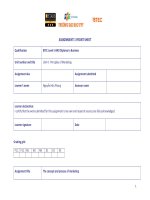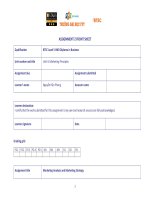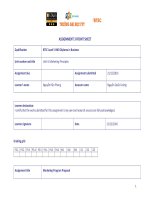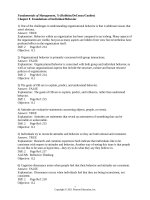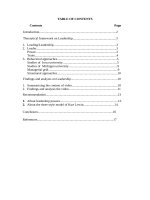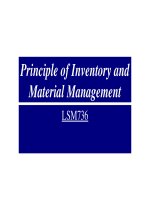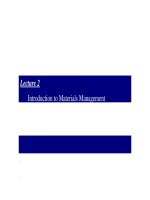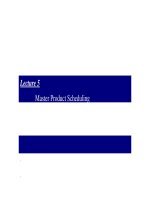08 principle of management assignment (1)
Bạn đang xem bản rút gọn của tài liệu. Xem và tải ngay bản đầy đủ của tài liệu tại đây (245.98 KB, 43 trang )
JAMNALAL BAJAJ INSTITUTE
OF MANAGEMENT STUDIES
PRINCIPLE OF MANAGEMENT
ASSIGNMENT
PROFESSOR - MANDKE
PREPARED BY S. G. Nadar
MMM – I
ROLL NO - 59
1
Q 1 Explain Principle of Management
Ans
The Principles of Management are the essential, underlying factors that form the foundations of
successful management. According to Henri Fayol (1841-1925) in his book General and Industrial
Management (1916), there are fourteen 'principles of management'.
Management principles are statements of fundamental truth. These principles serve as
guidelines for decisions and actions of managers. They are derived through observation and
analysis of events which managers have to face in practice.
1. Division of Work The specialization of the workforce, creating specific personal and professional development
within the labour force and therefore increasing productivity; leads to specialization which
increases the efficiency of labour. By separating a small part of work, the workers speed and
accuracy in its performance increases. This principle is applicable to both technical as well as
managerial work.
2. Authority and ResponsibilityThe issue of commands followed by responsibility for their consequences. Authority means
the right of a superior to give order to his subordinates; responsibility means obligation for
performance. This principle suggests that there must be parity between authority and
responsibility.. They are co-existent and go together, and are two sides of the same coin.
3. DisciplineDiscipline refers to obedience, proper conduct in relation to others, respect of authority, etc. It
is essential for the smooth functioning of all organizations.
4. Unity of Command This principle states that every subordinate should receive orders and be accountable to one
and only one superior. If an employee receives orders from more than one superior, it is
likely to create confusion and conflict.
Unity of Command also makes it easier to fix responsibility for mistakes.
5. Unity of Direction 2
All those working in the same line of activity must understand and pursue the same
objectives. All related activities should be put under one group, there should be one plan of
action for them, and they should be under the control of one manager.
It seeks to ensure unity of action, focusing of efforts and coordination of strength.
6. Subordination of Individual Interest
The management must put aside personal considerations and put company objectives first.
Therefore the interests of goals of the organization must prevail over the personal interests of
individuals.
7. Remuneration Workers must be paid sufficiently as this is a chief motivation of employees and therefore
greatly influences productivity. The quantum and methods of remuneration payable should be
fair, reasonable and rewarding of effort.
8. The Degree of Centralization The amount of power wielded with the central management depends on company size.
Centralization implies the concentration of decision making authority at the top management.
Sharing of authority with lower levels is called decentralization. The organization should
strive to achieve a proper balance.
9. Scalar Chain Scalar Chain refers to the chain of superiors ranging from top management to the lowest rank.
The principle suggests that there should be a clear line of authority from top to bottom linking
all managers at all levels. It is considered a chain of command. It involves a concept called a
"gang plank" using which a subordinate may contact a superior or his superior in case of an
emergency,defying the hierarchy of control.However the immediate superiors must be
informed about the matter
10. Order -
3
Social order ensures the fluid operation of a company through authoritative procedure.
Material order ensures safety and efficiency in the workplace.
11. Equity Employees must be treated kindly, and justice must be enacted to ensure a just workplace.
Managers should be fair and impartial when dealing with employees.
12. Stability of Tenure of Personnel The period of service should not be too short and employees should not be moved from
positions frequently. An employee cannot render useful service if he is removed before he
becomes accustomed to the work assigned to him.
13. Initiative Using the initiative of employees can add strength and new ideas to an organization. Initiative
on the part of employees is a source of strength for the organization because it provides new
and better ideas. Employees are likely to take greater interest in the functioning of the
organization.
14. Esprit de Corps This refers to the need of managers to ensure and develop morale in the workplace;
individually and communally. Team spirit helps develop an atmosphere of mutual trust and
understanding.
These can be used to initiate and aid the processes of change, organization, decision making,
skill management and the overall view of the management function.
Fayol also divided the management function into five key roles:
•
To organise
•
To plan and forecast (Prevoyance)
•
To command
•
To control
•
To coordinate
4
Q 2 Explain management and its functions
Ans
Management is creative problem solving. This creative problem solving is accomplished
through four functions of management: planning, organizing, leading and controlling. The
intended result is the use of an organization's resources in a way that accomplishes its mission
and objectives
Planning is the ongoing process of developing the business' mission and objectives and
determining how they will be accomplished. Planning includes both the broadest view of the
organization, e.g., its mission, and the narrowest, e.g., a tactic for accomplishing a specific
goal.
Organizing is establishing the internal organizational structure of the organization. The focus
is on division, coordination, and control of tasks and the flow of information within the
organization. It is in this function that managers distribute authority to job holders.
Staffing is filling and keeping filled with qualified people all positions in the business.
Recruiting, hiring, training, evaluating and compensating are the specific activities included
in the function. In the family business, staffing includes all paid and unpaid positions held by
family members including the owner/operators.
Directing is influencing people's behavior through motivation, communication, group
dynamics, leadership and discipline. The purpose of directing is to channel the behavior of all
personnel to accomplish the organization's mission and objectives while simultaneously
helping them accomplish their own career objectives.
Controlling is a four-step process of establishing performance standards based on the firm's
objectives, measuring and reporting actual performance, comparing the two, and taking
corrective or preventive action as necessary.
Each of these functions involves creative problem solving. Creative problem solving is
broader than problem finding, choice making or decision making. It extends from analysis of
the environment within which the business is functioning to evaluation of the outcomes from
the alternative implemented.
5
Q 3. Explain controlling
Ans:
Controlling involves ensuring that performance does not deviate from standards. Controlling
consists of three steps, which include establishing performance standards, comparing actual
performance against standards, and taking corrective action when necessary. Performance
standards are often stated in monetary terms such as revenue, costs, or profits, but may also
be stated in other terms, such as units produced, number of defective products, or levels of
customer service.
The measurement of performance can be done in several ways, depending on the
performance standards, including financial statements, sales reports, production results,
customer satisfaction, and formal performance appraisals. Managers at all levels engage in
the managerial function of controlling to some degree.
The managerial function of controlling should not be confused with control in the behavioral
or manipulative sense. This function does not imply that managers should attempt to control
or manipulate the personalities, values, attitudes, or emotions of their subordinates. Instead,
this function of management concerns the manager's role in taking necessary actions to
ensure that the work-related activities of subordinates are consistent with and contributing
toward the accomplishment of organizational and departmental objectives.
Effective controlling requires the existence of plans, since planning provides the necessary
performance standards or objectives. Controlling also requires a clear understanding of where
responsibility for deviations from standards lies. Two traditional control techniques are the
budget and the performance audit. Although controlling is often thought of in terms of
financial criteria, managers must also control production/operations processes, procedures for
delivery of services, compliance with company policies, and many other activities within the
organization.
The management functions of planning, organizing, leading, and controlling are widely
considered to be the best means of describing the manager's job as well as the best way to
classify accumulated knowledge about the study of management. Although there have been
tremendous changes in the environment faced by managers and the tools used by managers to
perform their roles, managers still perform these essential functions.
6
Q.4 Explain Lillian gilberth
Ans:
Lillian Gilbreth was the mother of modern management. Together with her husband Frank,
she pioneered industrial management techniques still in use today. She was one of the first
"superwomen" to combine a career with her home life. She was a prolific author, the
recipient of many honorary degrees, and the mother of 12. She is perhaps best remembered
for motherhood. Her children wrote the popular books Cheaper by the Dozen and Belles on
Their Toes about their experiences growing up with such a large and famous family. But
Lillian Moller Gilbreth was not only a mother; she was an engineer and an industrial
psychologist.
Lillian excelled in high school and decided that she wanted to study literature and music. Her
father did not believe in higher education for women. He felt they needed only enough
knowledge to manage a home gracefully. But Lillian persuaded him to let her attend the
University of California at Berkeley while living at home and maintaining her family duties.
When she obtained her B.A. in literature in 1900, she was the first woman to speak at a
University of California commencement.
She went to Columbia, but illness forced a return to California after her first year. Undaunted,
she went back to Berkeley and received a master's degree in literature in 1902. She celebrated
by planning a vacation. She spent some time in Boston before embarking, and there she met
her future husband.
Frank Gilbreth, who never went to college, was interested in efficiency in the workplace. His
enthusiasm for the subject was contagious. He proposed to Lillian Moller three weeks after
her return from Europe, and together they began their study of scientific management
principles. Frank started a consulting business and Lillian worked at his side. They began
their family and in 1910 moved to Rhode Island, where Gilbreth took her doctorate in
psychology at Brown University in 1915--with four young children in tow at the ceremony.
But where Frank was concerned with the technical aspects of worker efficiency, Lillian was
concerned with the human aspects of time management. Her ideas were not widely adopted
during her lifetime, but they indicated the direction that modern management would take. She
recognized that workers are motivated by indirect incentives (among which she included
money) and direct incentives, such as job satisfaction. Her work with Frank helped create job
7
standardization, incentive wage-plans, and job simplification. Finally, she was among the
first to recognize the effects of fatigue and stress on time management.
Lillian Gilbreth continued her work alone after Frank's death in 1924. In 1926, she became
the first woman member of the American Society of Mechanical Engineers. She went to
Purdue in 1935 as a professor of management and the first female professor in the
engineering school. In her consulting business, she worked with GE and other firms to
improve the design of kitchens and household appliances. She even created new techniques to
help disabled women accomplish common household tasks.
She did not retire from professional work until she was in her 80s. She traveled widely,
speaking and writing about management issues. In 1966, she won the Hoover Medal of the
American Society of Civil Engineers. She died at the age of 92, the recipient of more than a
dozen honorary degrees. Her ability to combine a career and family led to her being called,
by the California Monthly in 1944, "a genius in the art of living."
Q 5. What are the contribution of Frederick Taylor
Ans:Frederick Taylor - Scientific Management
Description
Frederick Taylor, with his theories of Scientific Management, started the era of modern
management. In the late nineteenth and early twentieth centuries, Frederick Taylor was
decrying the " awkward, inefficient, or ill-directed movements of men" as a national loss. He
advocated a change from the old system of personal management to a new system of
scientific management. Under personal management, a captain of industry was expected to be
personally brilliant. Taylor claimed that a group of ordinary men, following a scientific
method would out perform the older "personally brilliant" captains of industry.
Taylor consistently sought to overthrow management "by rule of thumb" and replace it with
actual timed observations leading to "the one best" practice. Following this philosophy he
also advocated the systematic training of workers in "the one best practice" rather than
allowing them personal discretion in their tasks. He believed that " a spirit of hearty
cooperation" would develop between workers and management and that cooperation would
ensure that the workers would follow the "one best practice." Under these philosophies
Taylor further believed that the workload would be evenly shared between the workers and
8
management with management performing the science and instruction and the workers
performing the labor, each group doing "the work for which it was best suited."
Taylor's strongest positive legacy was the concept of breaking a complex task down in to a
number of small subtasks, and optimizing the performance of the subtasks. This positive
legacy leads to the stop-watch measured time trials which in turn lead to Taylor's strongest
negative legacy. Many critics, both historical and contemporary have pointed out that
Taylor's theories tend to "dehumanize" the workers. To modern readers, he stands convicted
by his own words:
" … in almost all of the mechanic arts, the science which underlies each act of each workman
is so great and amounts to so much that the workman who is best suited to actually doing the
work is incapable of fully understanding this science, without the guidance and help of those
who are working with him or over him, either through lack of education or through
insufficient mental capacity."
And:
"to work according to scientific laws, the management must takeover and perform much of
the work which is now left to the men; almost every act of the workman should be preceded
by one or more preparatory acts of the management which enable him to do his work better
and quicker than he otherwise could."
The Principles of Scientific Management
Environment
Taylor's work was strongly influenced by his social/historical period. His lifetime (18561915) was during the Industrial Revolution. The overall industrial environment of this period
is well documented by the Dicken's classic Hard Times or Sinclar's The Jungle. Autocratic
management was the norm. The manufacturing community had the idea of interchangeable
parts for almost a century. The sciences of physics and chemistry were bringing forth new
miracles on a monthly basis.
One can see Taylor turning to "science" as a solution to the inefficiencies and injustices of the
period. His idea of breaking a complex task into a sequence of simple subtasks closely
9
mirrors the interchangeable parts ideas pioneered by Eli Whitney earlier in the century.
Furthermore, the concepts of training the workers and developing "a hearty cooperation"
represented a significant improvement over the feudal human relations of the time.
Successes
Scientific management met with significant success. Taylor's personal work included papers
on the science of cutting metal, coal shovel design, worker incentive schemes and a piece rate
system for shop management. Scientific management's organizational influences can be seen
in the development of the fields of industrial engineering, personnel, and quality control.
From an economic standpoint, Taylorism was an extreme success. Application of his methods
yielded significant improvements in productivity. Improvements such as Taylor's shovel
work at Bethlehem Steel Works (reducing the workers needed to shovel from 500 to 140)
were typical.
Q 6. Contribution of George Elton Mayo's Hawthorne Experiments
Ans:- Henri Fayol - Administration
The Studies
The Hawthorne Studies (or experiments) were conducted from 1927 to 1932 at the Western
Electric Hawthorne Works in Chicago, where Harvard Business School professor Elton Mayo
examined productivity and work conditions. Studies grew out of preliminary experiments at
the plant from 1924 to 1927 on the effect of light on productivity. Those experiments showed
no clear connection between productivity and the amount of illumination but researchers
began to wonder what kind of changes would influence output.
Variables Affecting Productivity
Specifically, Mayo wanted to find out what effect fatigue and monotony had on job
productivity and how to control them through such variables as rest breaks, work hours,
temperature and humidity. In the process, he stumbled upon a principle of human motivation
that would help to revolutionize the theory and practice of management.
Mayo took six women from the assembly line, segregated them from the rest of the factory
and put them under the eye of a supervisor who was more a friendly observer than
10
disciplinarian. Mayo made frequent changes in their working conditions, always discussing
and explaining the changes in advance. He changed the hours in the working week, the hours
in the workday the number of rest breaks. the time of the lunch hour. Occasionally, he would
return the women to their original, harder working conditions.
Relay assembly
The investigators selected two girls for their second series of experiments and asked them to
choose another four girls, thus making a small group of six. The group was employed in
assembling telephone relays - a relay being a small but intricate mechanism composed of
about forty separate parts which had to be assembled by the girls seated at a lone bench and
dropped into a chute when completed. The relays were mechanically counted as they slipped
down the chute. It was intended that the basic rate of production should be noted at the start,
and that subsequently changes would be introduced, the effectiveness of which would be
measured by increased or decreased production of the relays.
Feedback mechanism
Through out the series of experiments, an observer sat with the girls in the workshop noting
all that went on, keeping the girls informed about the experiment, asking for advice or
information, and listening to their complaints. The experiment began by introducing various
changes, each of which was continued for a test period of four to twelve weeks. The results of
these changes are as follows:
Conditions and results
The experimental group had considerable freedom of movement. They were not pushed
around or bossed by anyone. Under these conditions they developed an increased sense of
responsibility and instead of discipline from higher authority being imposed, it came from
within the group itself.
Q 7. Explain informal organaziation
Ans:The Informal Organization
11
In addition to formal organizational structures, an organization may also have a hidden side
that doesn't show up on its organizational chart. This hidden informal organization is defined
by the patterns, behaviors, and interactions that stem from personal rather than official
relationships.
In the informal organization, the emphasis is on people and their relationships; in the formal
organization, the emphasis is on official organizational positions. The leverage, or clout, in
the informal organization is informal power that's attached to a specific individual. On the
other hand, in the formal organization, formal authority comes directly from the position. An
individual retains formal authority only so long as he or she occupies the position. Informal
power is personal; authority is organizational.
Firmly embedded within every informal organization are informal groups and the notorious
grapevine; the following list offers descriptions of each:
Informal groups. Workers may create an informal group to go bowling, form a union,
discuss work challenges, or have lunch together every day. The group may last for several
years or only a few hours. Sometimes employees join these informal groups simply because
of its goals. Other times, they simply want to be with others who are similar to them. Still
others may join informal groups simply because they want to be accepted by their coworkers.
The grapevine. The grapevine is the informal communications network within an
organization. It is completely separate from — and sometimes much faster than — the
organization's formal channels of communication.
Formal communication usually follows a path that parallels the organizational chain of
command. By contrast, information can be transmitted through the grapevine in any direction
— up, down, diagonally, or horizontally across the organizational structure. Subordinates
may pass information to their bosses, an executive may relay something to a maintenance
worker, or employees in different departments may share tidbits.
Grapevine information may be concerned with topics ranging from the latest management
decisions to the results of today's World Series game to pure gossip. The information may be
important or of little interest. By the same token, the information on the grapevine may be
highly accurate or totally distorted.
12
The informal organization of a firm may be more important than a manager realizes.
Although managers may think that the informal organization is nothing more than rumors
that are spread among the employees, it is actually a very important tool in maintaining
company-wide information flow. Results of studies show that the office grapevine is 75
percent to 90 percent accurate and provides managers and staff with better information than
formal communications.
Rather than ignore or try to suppress the grapevine, managers should make an attempt to tune
in to it. In fact, they should identify the people in the organization who are key to the
information flow and feed them information that they can spread to others. Managers should
make as big an effort to know who their internal disseminators of information are as they do
to find the proper person to send a press release. Managers can make good use of the power
of the informal organization and the grapevine
Q 8. Explain informal organaziation
Ans:Formal organization
A formal organization refers to the structure of well defined jobs, each bearing a definite
measure of authority, responsibility and accountability. Thus, a formal organization is created
through the co-ordination of efforts of various individuals. Every member is responsible for
the performance of a specified task assigned to him on the basis of authority responsibility
relationship in an organization.
1.
(i)
To employees
Sense of belonging: In a formal organization, there is lack of sense of belongingness
and personal satisfaction.
(ii)
Value for emotional problems: In the daily work routine there are many
opportunities for tension and frustration.
(iii)
Aid on the job: In case of accidents or illness, members of an informal group help one
another.
(iv)
Innovation and originality: By enabling members to modify the job situation more to
their liking, the informal organization creates the necessary environment for individual
innovation and originality. The individual can experiment with his ideas.
13
(v)
Important channel of communication: News travels quickly via informal groups.
They are the clandestine transmitters and receivers of information before it is officially
released.
(vi)
Social control: Informal groups provide all its members a set of norms or guides to
correct behavior. Members are expected to conform to those norms.
(vii) Check on authority: Informal group forces the manager to plan and act more
carefully than he would otherwise. Informal organization is a check and balance on unlimited
use of authority by a manager.
2.
(i)
To management
Less supervision: Informal group is self-policing. This relieves the management of
much of the burden of supervision.
(ii)
An aid to management: The information gives the manager much feedback about
employees and their work experiences thereby increasing his understanding of what he needs
to do.
Disadvantages of an Informal organization
(i)
Resistance to change: An informal organization is bound by customs, conventions
and culture.
(ii)
Role conflict and sub-optimization: In an informal organization, everyone works
towards the same objectives. Members put their own group objectives ahead of
organization’s objectives. Hence, the organization suffers.
(iii)
(iv)
Rumour: An informal organization sometimes functions as a carrier of rumor.
Group think philosophy: Workers become loyal to their groups.
Q 9. What do you understand by M.B.O. Explain?
Ans
Management by objectives (MBO) is a systematic and organized approach that allows
management to focus on achievable goals and to attain the best possible results from
available resources.
It aims to increase organizational performance by aligning goals and subordinate objectives
throughout the organization. Ideally, employees get strong input to identify their objectives,
time lines for completion, etc. MBO includes ongoing tracking and feedback in the process to
reach objectives.
Management by Objectives (MBO) was first outlined by Peter Drucker in 1954 in his book
'The Practice of Management'. In the 90s, Peter Drucker himself decreased the significance of
14
this organization management method, when he said: "It's just another tool. It is not the great
cure for management inefficiency... Management by Objectives works if you know the
objectives, 90% of the time you don't."
Core Concepts
According to Drucker managers should "avoid the activity trap", getting so involved in their
day to day activities that they forget their main purpose or objective. Instead of just a few top
managers, all managers should:
participate in the strategic planning process, in order to improve the implementability of the
plan, and
implement a range of performance systems, designed to help the organization stay on the
right track.
Managerial Focus
MBO managers focus on the result, not the activity. They delegate tasks by "negotiating a
contract of goals" with their subordinates without dictating a detailed roadmap for
implementation. Management by Objectives (MBO) is about setting yourself objectives and
then breaking these down into more specific goals or key results.
Main Principle
The principle behind Management by Objectives (MBO) is to make sure that everybody
within the organization has a clear understanding of the aims, or objectives, of that
organization, as well as awareness of their own roles and responsibilities in achieving those
aims. The complete MBO system is to get managers and empowered employees acting to
implement and achieve their plans, which automatically achieve those of the organization.
Where to Use MBO
The MBO style is appropriate for knowledge-based enterprises when your staff is competent.
It is appropriate in situations where you wish to build employees' management and selfleadership skills and tap their creativity, tacit knowledge and initiative.
15
Q. 10 Write short note of McKinseys7S
Ans.
M a c’ s 7 S – McKensey’s Model
Strategy
Structure
Skill
Super-ordinate
Goals of org
Style
System
Staff
This is one of the recently developed models of management. The model was developed by
the widely respected consulting firm of McKinsey and Company. It is based on two best
selling books, namely, The Art of Japanese Management and In Search of Excellence. The
model was tested extensively by McKinsey’s consultants in their studies of many companies.
This frame work has also been used by respected business schools such as Harvard and
Stanford. Thus Theory and Practice support each other.
However, if effort to get all the attributes starting with ‘S’, (to serve as memory hook)
meaning of some of the terms had to be stretched. Like while ‘skills’ is used for personal
skills, here it stands for capabilities of the organisation as a whole.
By Super-ordinate Goals, the theorists have emphasised that goal statements are very
important in determining the destiny of the enterprise. They also point out that values must
be shared by organisation members. Therefore special attention is to be given to personal and
organisational values.
16
Q 11. Write short notes on Line and Staff .
Ans.
Line and Staff Organisation
One of the ways to classify the diverse functions of an organisation is to divide them into line
and staff functions. The words line and staff are basically euphemisms for main and support
functions. The line functions are defined as those that contribute directly to accomplishment
of the objectives of the enterprise where as staff functions are those which help the line
persons to execute their tasks more efficiently and effectively. Accordingly, production and
sales (and some times finance also) are termed as line and planning, purchasing, accounting,
personnel, plant maintenance and quality control are regarded as staff functions.
Unfortunately, this division has been a constant source of debate and friction amongst the
managers and the academicians. The separating line between two functions is very thin and
many functions fall in the grey area. Often one function regarded as line by one authority is
termed as staff by another. Take for instance, Tool Room in-charge in a production shop.
While the Headquarter authorities classify the job as line function, the machine operator in
the same shop is not willing to accept it as such.. The purpose of the staff personnel is to
investigate, research, assist and give advice to the line people.
The line and staff personnel are quite often at loggerheads. Both have grouse against each
other. However, such grouse are minimised by cross training/rotation of staff and line
appointments whereby every person gets to work in both kinds of jobs and thus understands
the functions and nuances of the other better. This method has been successfully adopted by
the Defence Forces.
Despite being enveloped by the constant debate, and being source of friction in the
organisation, this method has its own undeniable advantages: -
Characteristics
1. Line executives command, they are doers
2. The staff specialists advice, they are thinkers
3. The staff plays a major part in planning the activity
4. The Line manager have clear and absolute authority for execution of decisions
17
Advantages of Line And Staff Type of Organisation.
1. Planned Specialisation. Allows hiring of super specialist to tackle problem.
2. Affords opportunity to investigate the problem thoroughly. Man involved in the day
to day production process will rarely have time to invest in research.
3. Bifurcation of conceptual and executive functions
4. Training ground
5. Sound decisions
6. Less burden on Line executive
7. Suitable for large organisations
Q 12. What are the Barriers to Organizational Communication ?
Ans.
Communication can be defined as, “transfer of thoughts and information from one person to
another person. Communication can be oral (Direct or telephonic or messanger), written
(letters, emails, sms) or even in sign language. Effective communication is vital for success in
any field. Improper and ineffective communication can be the difference between success and
failure. Communication is a difficult art and requires careful handling to avoid disastrous
results.
Communication could be a one way or two way process. But for the communication
to be effective and reliable, it should be two way as far as possible.
Communication can be in three directions:
1.
Upward – From subordinates/workers to senior officers/management.
2.
Downward – From Superiors/management to subordinates and workers.
3.
Lateral – Between colleagues, peers, interdepartmental meetings, etc.
COMMUNICATION PROCESS
FEED BACK
Thoughts
Encode
SENDER
Transmission
Receive
Decode
Understand
RECEIVER
18
In the above process, the error could occur at any point resulting in unplanned effects and
results.
ABC of Communication.
In the most simplistic form, an effective communication has to
have three independent attributes A, B & C, ie
A – Accurate
B – Brief
C – Clear
Further elaborated, 7 cardinals of effective communication are as follows: 1. Candid
2. Clear
3. Complete
4. Concise
5. Concrete – No vagueness, Definite
6. Correct
7. Courteous
Communication is rarely with 100% accuracy. There will always be distortions in
communication due to either failure to code the message or decode and understand the
message correctly. The reasons for above failure are many. These reasons are termed as
Barriers in communication. They could be grouped as follows: 1.
Personal Barriers.
1. Human emotions
2. Love
3. Fear
4. Anger
5. Distrust
6. Difference in Values between two people
7. Poor Listening – Hearing is with ears while listening is with mind
(attentiveness is the keyword in listening)
8. Perceptions – Opinionated, etc
9. Inappropriate gestures and postures
10. Deficiency of knowledge of receiver (in technical matters)
2.
Physical Barriers.
1. Interference
19
2. Noise
3. Distance
4. Physical
5. Hierarchical
3.
Semantic Barriers.
(a) Multiple Meaning Words
(b) Language
4.
Cultural Barriers. People from different cultures will decode the same thing
differently.
Improving Communication. Communication can be greatly improved if some simple steps
are observed diligently.
1.
The sender should format and code his message keeping the
attributes/environment of receiver in mind. Like critical messages should be avoided
when the person is in high emotional state. Similarly, if a person is working in high
noise area, it is better to send a small note rather than shout out the instructions.
2.
Keep the message short and sweet. Long messages are often not
read fully or read at high speed with little understanding.
3.
Any message should have as few intermediaries as possible since
there is loss of accuracy at each transmission and reception.
4.
Only simple and familiar words and phrases should be used.
5.
Avoid jargon, slang and colloquiums.
Q 13. Explain Theory X and Theory Y
Ans.
McGregor, in his book “The Human side of Enterprise” states that people inside the
organization can be managed in two ways. The first is basically negative, which falls under
the category X and the other is basically positive, which falls under the category Y. After
viewing the way in which the manager dealt with employees, McGregor concluded that a
manager’s view of the nature of human beings is based on a certain grouping of assumptions
and that he or she tends to mold his or her behavior towards subordinates according to these
assumptions.
20
Under the assumptions of theory X :
•
Employees inherently do not like work and whenever possible, will attempt to avoid
it.
•
Because employees dislike work, they have to be forced, coerced or threatened with
punishment to achieve goals.
•
Employees avoid responsibilities and do not work fill formal directions are issued.
•
Most workers place a greater importance on security over all other factors and display
little ambition.
In contrast under the assumptions of theory Y :
•
Physical and mental effort at work is as natural as rest or play.
•
People do exercise self-control and self-direction and if they are committed to those
goals.
•
Average human beings are willing to take responsibility and exercise imagination,
ingenuity and creativity in solving the problems of the organization.
•
That the way the things are organized, the average human being’s brainpower is only
partly used.
On analysis of the assumptions it can be detected that theory X assumes that lower-order
needs dominate individuals and theory Y assumes that higher-order needs dominate
individuals. An organization that is run on Theory X lines tends to be authoritarian in nature,
the word “authoritarian” suggests such ideas as the “power to enforce obedience” and the
“right to command.” In contrast Theory Y organizations can be described as “participative”,
where the aims of the organization and of the individuals in it are integrated; individuals can
achieve their own goals best by directing their efforts towards the success of the organization.
However, this theory has been criticized widely for generalization of work and human
behavior.
Q 14. Explain Abraham Maslow Theory.
Ans
Abraham Maslow’s “Need Hierarchy Theory” :
21
One of the most widely mentioned theories of motivation is the hierarchy of needs theory put
forth by psychologist Abraham Maslow. Maslow saw human needs in the form of a
hierarchy, ascending from the lowest to the highest, and he concluded that when one set of
needs is satisfied, this kind of need ceases to be a motivator.
As per his theory this needs are :
(i) Physiological needs :
These are important needs for sustaining the human life. Food, water, warmth, shelter, sleep,
medicine and education are the basic physiological needs which fall in the primary list of
need satisfaction. Maslow was of an opinion that until these needs were satisfied to a degree
to maintain life, no other motivating factors can work.
(ii) Security or Safety needs :
These are the needs to be free of physical danger and of the fear of losing a job, property,
food or shelter. It also includes protection against any emotional harm.
(iii) Social needs :
Since people are social beings, they need to belong and be accepted by others. People try to
satisfy their need for affection, acceptance and friendship.
(iv) Esteem needs :
According to Maslow, once people begin to satisfy their need to belong, they tend to want to
be held in esteem both by themselves and by others. This kind of need produces such
satisfaction as power, prestige status and self-confidence. It includes both internal esteem
factors like self-respect, autonomy and achievements and external esteem factors such as
states, recognition and attention.
(v) Need for self-actualization :
Maslow regards this as the highest need in his hierarchy. It is the drive to become what one is
capable of becoming, it includes growth, achieving one’s potential and self-fulfillment. It is
to maximize one’s potential and to accomplish something.
22
As each of these needs are substantially satisfied, the next need becomes dominant. From the
standpoint of motivation, the theory would say that although no need is ever fully gratified, a
substantially satisfied need no longer motivates. So if you want to motivate someone, you
need to understand what level of the hierarchy that person is on and focus on satisfying those
needs or needs above that level.
Maslow’s need theory has received wide recognition, particularly among practicing
managers. This can be attributed to the theory’s intuitive logic and ease of understanding.
However, research does not validate these theory. Maslow provided no empirical evidence
and other several studies that sought to validate the theory found no support for it.
Q. 15 What is planning? What are the various types of plans prepared by an
organisation?
Answer:
Plainly speaking, Planning is deciding in advance what to do, how to do, when to do, where
to do, and who is to do it. Planning involves selection selecting missions and objectives and
the actions to achieve them. It requires decision making, that is, choosing from among
alternative future courses of action. Planning bridges the gap between where we are and
where we want to go.
Nature and Characteristics of Planning
Planning is goal oriented. Plans are developed and executed to achieve goals.
23
Future Oriented. Necessary forecasts are made about future and accordingly plans are based
on them.
Continuous Activity. Effective planning requires constant and continuous checking of
events.
Primacy of Planning. Planning is the primary and basic function of Management.
Planning is an Intellectual Process. A great deal of imagination and intelligence is needed
to prepare a sound plan.
Pervasiveness of Planning. It exists at every level of management, however high or low.
Planning Provides a Sense of Direction. Planning bridges gap between where we are and
where we want to go.
Integrated Process. Every plan needs to be integrated with other plans to achieve
organisational goals.
Flexibility. Plans should be flexible as plans are based on parameters which may be highly
dynamic.
Generates Efficiency. Planning generates efficiency due to optimum utilisation of resources.
Steps in Planning.
Being Aware of Opportunities. Awareness of opportunities in light of competition, our
strengths and weakness is the real starting point for planning.
Setting objectives or Goals. Objectives are set for the entire enterprise in all the key areas
of operations, productions, marketing and finance.
Considering planning premises.
Assumptions or forecasts of future and known conditions
that will affect operation of plans.
Determining alternatives courses.
Examine alternative courses of action.
24
Evaluating alternative courses. Weighing the various alternatives in the light of presmises
and goals.Select the course of action from alternatives.
Formulate Derivative Plans. Derivative plans are required to support the basic plan.,
programmes. Budgets, schedules, etc are some of the examples
Establishing Sequence of Activity. Sequence of activity is determined in such a manner as
to put plan to action. Budgets can be prepared to give more meaning to plans for
implementation.
Types of Plans.
Plans can be classified as: 1.
2.
3.
4.
5.
6.
7.
8.
Purpose or Mission
Objective or goal
Strategies
Policies
Procedures
Rules
Programs
Budgets
They can also be classified as per duration: Short Term Plans - Plans for period of 01 day to one year – Operational Plans.
Medium Term Plans – Plans for 1 – 2 years – Tactical Plans
Long Term Plans – Plans from 2 – 5 years perspective – Strategic Plans
Hierarchy of Plans
Purpose
Or Mission
Objective or Goal
Strategy
Policies – Major/minor
Procedures
Rules
Programme- Major/Minor/supporting
Budget – Numerised Program
25
